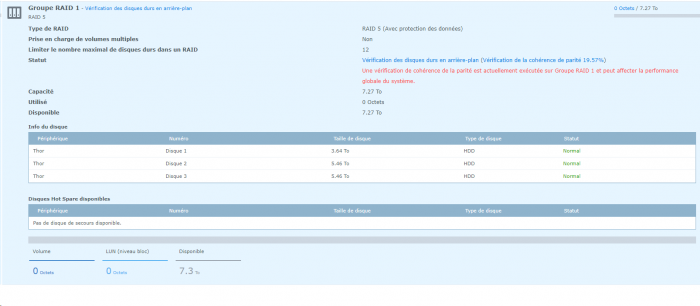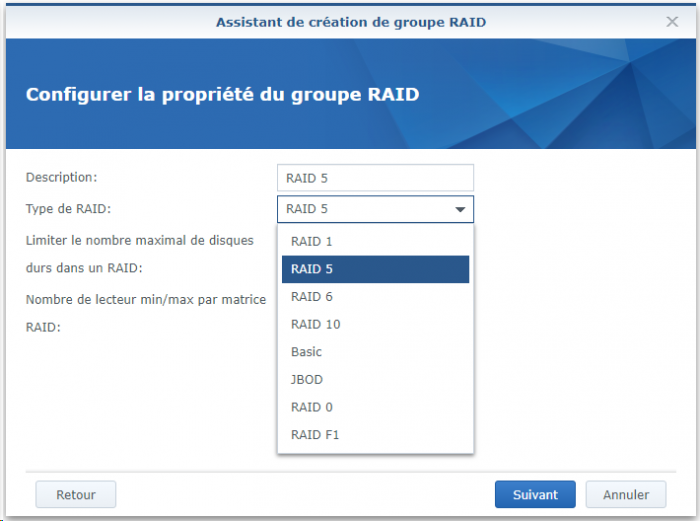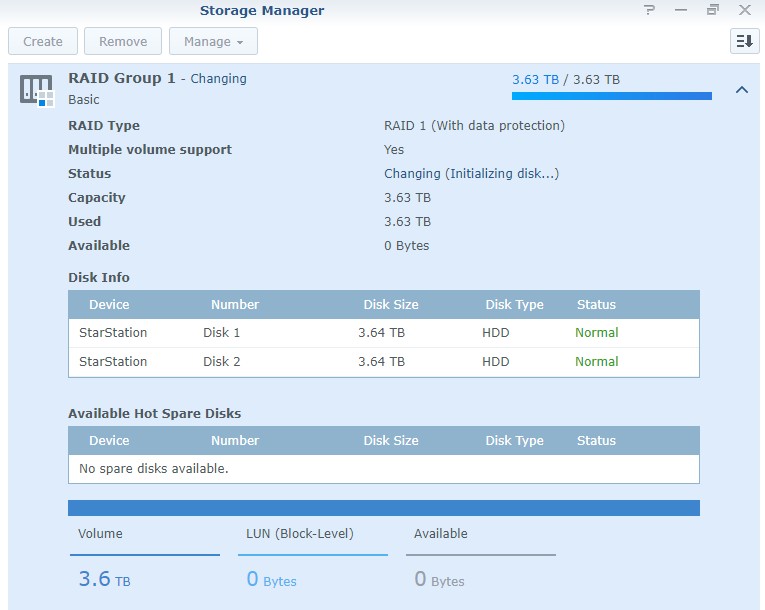Search the Community
Showing results for tags 'raid'.
-
I have an HP prodesk 400 G1 laying around and have decided to build a NAS. My co-worker recommended this operating system and I've created a flash drive boot loader. It looks like it will work, so the next step is to populate it with disks and a RAID controller. The HP prodesk has three mini PCIe interfaces on the motherboard. I think I can fit 4 or 5 HDD's in the case. Can someone recommend the best mini PCIe RAID card for something like this? Thanks in advance.
-
i wonder if these components will work nicely with DSM 6.2.3 ds918 loader i'm going to create a raid 10 https://ark.intel.com/content/www/us/en/ark/products/190886/intel-core-i3-9100f-processor-6m-cache-up-to-4-20-ghz.html https://asrock.com/mb/intel/b365m pro4/index.asp#Overview https://www.amazon.it/gp/product/B01LOOJBQY/ref=ewc_pr_img_4?smid=A20TIXVFK0Z53C&psc=1 https://www.amazon.it/gp/product/B084GRMJFS/ref=ox_sc_act_title_6?smid=A11IL2PNWYJU7H&psc=1 thanks
-
Hi, I am new to Xpenology and Proxmox but I just managed to install Xpenology DSM 6.2.3 on Proxmox 6.2-4. DSM was assigned a single disk that is created by Proxmox from a RAID10 (mirrored striped) ZFS storage. Seeing that this disk used by DSM already has redundancy from the underlying ZFS storage and also has some features similar to BTRFS like snapshots, replication, quotas, integrity protection, Is it redundant to use BTRFS instead of ext4 for a new volume in DMS? Should we use 'Basic', 'JBOD' for the storage pool in DMS? DSM only sees a single disk here. Thank you for any guidance on this issue!
-
Bonjour a tous J'ai un groupe en raid 10 a l origine c etait 4 disques de 1to. Un des disque est mort, je me suis dit, tant qu a faire: "achetes un 4to pour le remplacer." Donc j ai 4to+3*1to=1.43to ?!! Je pense qu il y a une truc que j ai pas compris, mais pas grave, je viens d' acheter un autre 4to. Mais comment arrivé au final a 2*4to en raid 1 = 4to? Si possible sans avoir a tout recreer mon groupe et volume, sachant que j ai des applis d installés sur ce volume. Voila, d'avance merci
-
Bonjour à tous. Je viens de repartir sur une version toute neuve en VM sur Esxi. Mais au moment de créer mon Raid, je m’aperçois que je ne retrouve plus le SHR ! Ce qui est fou, c'est que j'ai 3 disques. 4To - 6To et 6To. Pourtant il me propose de créer un raid 5 ! ce qui à ma connaissance n'est pas possible. Normalement, en Raid 5 les 3 disques devraient être de la même taille. Seul le Shr peut créer un Raid avec des disques de tailles différentes ! ? Si quelqu'un peut confirmer. De plus, je devrait avoir un volume total de 10To alors que là, je n'ai de 7To. Une idée ? Peut être ai-je mal fait mon install ? Merci pour vos idées.
- 3 replies
-
- raid
- configuration
-
(and 1 more)
Tagged with:
-
A little background... I've been thinking about setting up a NAS for quite a while. Recently my family decided to digitize the entire stockpile of VHS and camcorder Hi8 home videos. After digitizing the first box, we calculate that it's going to take many terabytes to get it all done. Cloud storage is looking to be hundreds of dollars a year. So I decided to pull the trigger and build a NAS to store them all along with all my other media. I have Roku's all through the house and purchased PLEX. Roku's have a great PLEX application. My co-worker suggested building my own NAS to save money and have a NAS capable of supporting PLEX transcoding and various other computing intensive activities desirable on a NAS. I'm using a Windows box with an I-3 processor and 12 GB RAM that was laying around. It had a couple of 500 GB drives and I added 2 more 4 TB drives with the expectation of upgrading the 500's over time. In another thread on this forum, I was told that all I needed was a supported SATA 3.0 expansion card with the port density I wanted and let DSM's software RAID controller do the work. I went with that advice and installed a four port SATA 3.0 card to give me 6 ports total including the 2 motherboard SATA 3.0 ports. Currently the 4 drives are attached to the card. I had small spare SSD drive that I connected to the motherboard that I intend to use as a cache. After the hardware build, I followed these instructions: https://github.com/XPEnology/JunLoader/wiki/Installing-DSM-6.0-Bare-Metal and successfully installed DSM from the .pat file linked to in this tutorial. Using the two 500 GB drives was based on my co-worker's experience of using SHR to have a redundant RAID setup with different sized drives and the ability to swap out a bad drive with a larger drive and/or upgrade to larger drives in the future. However after the install, when attempting to build the RAID group, there is no SHR option. Some quick research revealed that not all versions of DSM support SHR. Here's a page that lists those versions: https://www.synology.com/en-us/knowledgebase/DSM/tutorial/Storage/Which_models_have_limited_support_for_Synology_Hybrid_RAID_SHR Looking in the specs of my DSM install shows that it thinks it's a DSM3615xs device. Sure enough, this is listed on the above page as not supporting SHR. So my questions are, should I pursue trying to install a version of DSM that does support SHR with the xpenology boot loader? I really like the idea of being able to use what ever size drives I want. If I set up a traditional RAID, I'll need to purchase two more 4 TB drives now and then I'd have to start all over if I want to increase drive size instead of adding more 4 TB drives. If SHR is desirable, what version of DSM should I use and where do I get it? Thanks
-
Hello everyone. This is my first post, and i am not sure if i should be doing two topics or not... but here it goes. I am new to Xpenology, it's awsome how some of you clever boys and girls managed to get this firmware running on normal hardware, Synology sure is a powerful beast and i never touched in one due to it being too expensive, but i can see how powerful they are now... This being said, i am trying to find a solution where i can boot from my recently created iscsi drive, that contains a boot file, what i am trying to do is to create something like a diskless system where i can boot to an operating system if i need to. also, i own an DL380E Gen8, this beast crashes as soon as i passthrough the p420 raid controller , so i am thinking about using another machine to run Xpenology , i am wondering if i should buy a new Raid controller, one that is more "compatible" with xpenology. what's your toughts? Many thanks
-
Общие FAQ / Общие часто задаваемые вопросы Перевод. Оригинал здесь https://xpenology.com/forum/topic/9392-general-faq/ Целью данного руководства являются ответы на обычно задаваемые вопросы! Это не раздел, где просят о помощи. Для этой цели Вы можете использовать форум. 1. Что такое XPEnology? XPEnology представляет собой основанный на Linux загрузчик, разработанный с целью эмулировать (оригинальный) загрузчик Synology, позволяющий операционной системе (ОС) Synology Disk Station Manager (DSM) работать на сторонних аппаратных средствах (читай: железе, выпущенном не компанией Synology) и эмулировать определённые модели устройств Diskstation. В случае последнего загрузчика, к эмулируемым моделям относятся: DS916, DS3615 и DS3617. 2. Законно ли использовать это? Операционная система Disk Station Manager (DSM) основана на открытом исходном коде и XPE/DSM использует преимущества, вытекающие из распространения и использования открытого кода. Вам всегда стоит использовать собственное суждение и читать перед установкой и использованием операционной системы DSM с XPEnology. Мы не можем быть ответственны за Ваши действия. * вопрос спорный, поскольку сама ОС DSM разработана на основе открытого исходного кода, однако она использует пакеты, которые лицензированы компанией Synology и подразумевают их использование при согласии с условиями лицензии. 3. Как насчёт использования Synology QuickConnect и других фирменных сервисов? QuickConnect и сервисы, которые используют серверы Synology, требуют подлинный серийный номер и MAC адрес Synology. Неправильное/неправомерное использование сервисов Synology не приветствуется XPE-сообществом. 4. Почему Менеджер (Мониторинг) Ресурсов показывает, что у меня двуядерный процессор core i3? Потому что это жёстко запрограммировано. Тем не менее это всего лишь "косметическая" особенность. Вы можете проверить с помощью следующей команды установленные в системе процессоры: 5. Как я могу получить доступ к своему NAS через Интернет? Есть несколько способов, но в любом случае Вам придётся настраивать перенаправление/проброс портов (port forwarding). Необходимые (задействованные по умолчанию) порты перечислены ниже, на сайте Synology: https://www.synology.com/ru-ru/knowledgebase/DSM/tutorial/General/What_network_ports_are_used_by_Synology_services Рекомендуется также настроить службу DDNS (Dynamic DNS) или на Вашем роутере/маршрутизаторе (см. руководство, прилагаемое к роутеру), или на NAS-устройстве, как показано в этом уроке: https://xpenology.com/forum/topic/7573-tutorial-setup-a-ddns-in-dsm/ Также рекомендуется использовать решение VPN для удалённого доступа для лучшей безопасности. 6. Какие настройки последовательного порта для консольного соединения с загрузчиком Jun's? Известно, что эти настройки работают в Putty: Показать содержимое COM1 Speed - 115200 Data Bits - 8 Stop Bits - 1 Parity - None Flow Control - None Hide 7. Куда я могу сообщить если обновление работает или не работает? Вы можете сделать это, перейдя по ссылке ниже. Пожалуйста, прочтите READ ME темы форума прежде чем сообщать что-либо. https://xpenology.com/forum/forum/78-critical-updates/ 8. Для чего нужен загрузчик и где сохраняется ОС DSM, когда я устанавливаю её на свой компьютер? Сколько места они занимают? Загрузчик имитирует внутренний чип, который находится в реальных устройствах Synology. Этот внутренний флэш-ключ содержит микропрограмму (ядро), необходимую для загрузки. Когда вы устанавливаете DSM благодаря загрузчику, DSM устанавливается на все диски, присутствующие в машине, а не на ваш USB диск, содержащий загрузчик. Теперь давайте предположим, что вы установили DSM, и решили обновить её. DSM будет обновляться на всех жестких дисках. Если обновление также поставляется с обновленной прошивкой (ядром), то оно также будет обновлено и на USB-ключе. Это в основном единственная часть, которая копируется в загрузчик. Вот почему в некоторых случаях, если у вас было работающее устройство XPEnology, которое по какой-то причине сломалось, и вы пытаетесь переустановить более раннюю версию DSM, Вы не сможете этого сделать, потому что ядро, содержащееся в USB-ключе, новее, чем в .PAT-файле, используемом для переустановки DSM. Теперь, когда Вы устанавливаете DSM, создаются два раздела. Системный Раздел (~2 ГБ) и раздел подкачки - SWAP (~2,4 ГБ), которые находятся в RAID1 (всегда). Каждый раз, когда вы добавляете новый диск в свой компьютер, он инициализируется, и на нем создаются два раздела и устанавливается DSM. Цель всего этого заключается в том, что до тех пор, пока у вас есть один рабочий диск, вы сможете загрузить DSM. 9. Как вернуть SHR RAID в новых версиях DSM? Добавлено 14/12/2019 по просьбе @i926 (Moderator) Начиная с версии DSM 6, Synology лишила нас поддержки по умолчанию, в создании гибридных массивов SHR и SHRII. Пользователем @A.S._id, были созданы скрипты, для удобства возвращения поддержки SHR и SHRII и обратно по умолчанию Включение поддержки SHR и SHRII : ssh admin@ Ваш ip sudo -s cd /etc.defaults sed -i '/^/s:supportraidgroup="yes":support_syno_hybrid_raid="yes":' synoinfo.conf reboot Отключение поддержки SHR и SHRII. Возврат к значению по умолчанию ssh admin@ Ваш ip sudo -s cd /etc.defaults sed -i '/^/s:support_syno_hybrid_raid="yes":supportraidgroup="yes":' synoinfo.conf reboot Решение проблемы, любезно предоставил @A.S._id, за что ему Респект и Уважуха 😉
-
I'm just getting started on my own bare metal installation but I have been running several true Synology systems for years. First things I noticed was the lack of SHR (Synology Hybrid Raid) as an option. Is this a hardware limitation or something else?
-
My situation is .... I have clean install DSM 6.1.3 in N54L, and migrating data from another server, finally, 1 X 4TB HD full of data in N54L (DSM 6.1.3) after that hotplug 2 new 4TB rebuild the raid from BASIC to Raid 5.... however, this N54L server running almost 4 days, i still got this raid changing info screen. PS: the data in this changing status cannot copy to other drive through share folder (win10 connect to this server) Q1) Usually, how long should it take from basic to raid 5 Q2) xpenology DSM's raid function is work ? since i have no raid card in my N54L Q3) If I remove the Disk 2, can i have all my data back ? maybe i backup my existing 4TB data in the basic mode HD, and fresh build a Raid 5 volume. I very appreciate someone can give me a clue, thanks so much
-
Hallo, ich habe die letzten 3 Wochen sehr viel gelesen ums Thema NAS Selbstbau. Ich habe aktuell ein QNAP216+. Ich hab etliche VMs aufgesetzt um das System zu finden, welches mir am besten gefällt. Probiert habe ich FreeNas, Nas4Free, DSM, Ubuntu Server. Das ganze dann auch noch auf ESXi und Proxmox um es variabler in der Weiterführung zu gestalten. Nach einigen Schwierigkeiten bin ich dann doch wieder bei DSM nativ Installation gelandet. Ich habe nun einige Threads hier gelesen und versuche mal den für mich günstigsten Fall darzustellen: 1. Loader auf Stick aufbringen (damit er später leichter geupdated werden kann) 2. nur eine Festplatte anbinden (am besten SSD) für die Software und Plugin Installation 3. andere Platten anbinden und Raid 5 bilden. Ist das so korrekt? Zudem hab ich gelesen dass manche Plugins für die 3617xs nicht funktionieren und man deshalb besser die 3615xs nehmen sollte. Weiß jemand welche Plugins nicht funktionieren. Ich habe den Loader 1.02b für die 3617xs verwendet und auf die derzeit aktuellste Version updaten. Läuft. Mein Plan ist es die Plugins, die nicht funktionieren in einer VM unter dem VMM laufen zu lassen. Ich würde dort einen Ubuntu Server installieren und dann entsprechend einbinden. Nun scheint der VMM nur mit einer Seriennummer der DSM zu funktionieren. Dazu muss ich hier eine Serial generieren. Ist das so korrekt? Hat jemand einen Ubuntu Server laufen unter DSM? Wichtig sind für mich folgende Funktionen: NAS Owncloud / Nextcloud VPN GIT Mediaserver / DLNA SMB Surveillance Station Sind diese Dinge ohne größere Eingriffe durchführbar? Oder sollte ich doch auf ein anderes System umsteigen? Und noch eine für mich ungeklärte Frage... Was ist / macht der Docker? Besten Dank im Vorraus. Dennis





